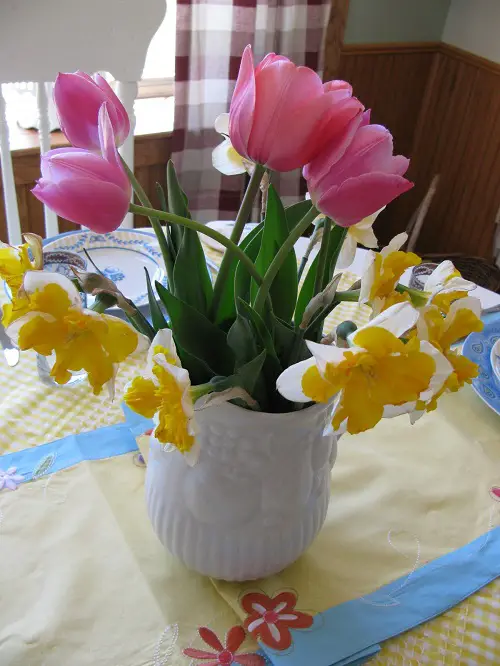Plant buddies that have each other’s backs—here are Bulbs that Bloom Beautifully Together Indoors, filling gaps and giving forever flowers!
As flowers die back, they can leave a void in your space. But pairing the right bulbs ensures you’re never without color, fragrance, and beauty. With combinations that stagger bloom times or complement each other, these bulbs bloom beautifully together indoors!
Bulbs that Bloom Beautifully Together Indoors
1. Tulips and Daffodils
Tulips come in many colors and intensities, from orange to lavender, while daffodils come in yellow, cream, and sunrise tints. You can choose bulbs that flower simultaneously and complement each other’s colors. Try deep purple tulips with bright yellow daffodils.
To grow tulips indoors, refrigerate the bulbs for a few weeks before sowing them. Both tulips and daffodils thrive in neutral to slightly acidic soil with a pH of 6.0-7.0 that is moist and well-draining. You can plant them together and trigger long-lasting spring blooms!
Pro tip: Remember to use high-quality, large bulbs for bigger flowers!
2. Hyacinths and Alliums
Plant hyacinths and alliums during the fall season for timely spring blooms! As hyacinths push out their tall, fragrant flowers early to mid-spring, alliums will emerge late spring to summer with their balloon-like clusters of tiny blooms in bright and pastel hues.
Alliums repel pests due to their garlic-like aroma, which adds a layer of protection to hyacinths. You can even plant alliums as late as December as long as the bulbs are firm and healthy. Both thrive in bright sun and well-draining soil.
3. Amaryllis Lily and Paperwhites

Amaryllis lilies and paperwhites belong to the Amaryllidaceae family and share similar growing needs and physical traits. The pair needs little babysitting and can adapt to a wide range of conditions, including dry soil types.
Grow paperwhites in water and then move them in with the lilies once they sprout. Remember to give both bulbs loads of bright, indirect light as soon as they start growing!
4. Freesia and Ranunculus
Freesia and ranunculus are herbaceous bulbous plants that love cool temperatures, sunny locations, and well-drained soil.
Freesias are known for their tall, slender stems and upward-facing flowers. On the other hand, ranunculus, with their more compact habit and abundant, often double blooms, add a lush, low-growing layer to the arrangement.
Note: Ranunculus contains a toxic compound called Protoanemonin, which is harmful to humans when ingested or directly contacted, so be careful.
5. Begonia and Caladium
You could also grow this colorful pair. Begonias are renowned for their attractive blooms, while caladiums are for their multicolored leaves. Both thrive together in shaded areas with moist, fertile soil and enjoy warm temperatures, typically between 65-75 F (18-24 C)
Caladiums are not exactly bulbs as they grow from tubers. However, they are similar to bulbous plants due to their planting needs.
Note: Begonias and caladiums contain calcium oxalate (the latter being more toxic) and must be kept away from toddlers and pets to avoid ingestion.






